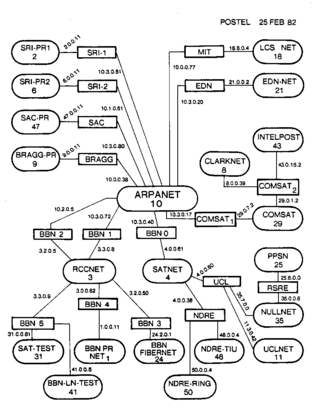Related Research Articles
An Internet Protocol address is a numerical label such as 192.0.2.1 that is assigned to a device connected to a computer network that uses the Internet Protocol for communication. IP addresses serve two main functions: network interface identification, and location addressing.
The Internet Control Message Protocol (ICMP) is a supporting protocol in the Internet protocol suite. It is used by network devices, including routers, to send error messages and operational information indicating success or failure when communicating with another IP address. For example, an error is indicated when a requested service is not available or that a host or router could not be reached. ICMP differs from transport protocols such as TCP and UDP in that it is not typically used to exchange data between systems, nor is it regularly employed by end-user network applications.

Internet Protocol version 4 (IPv4) is the first version of the Internet Protocol (IP) as a standalone specification. It is one of the core protocols of standards-based internetworking methods in the Internet and other packet-switched networks. IPv4 was the first version deployed for production on SATNET in 1982 and on the ARPANET in January 1983. It is still used to route most Internet traffic today, even with the ongoing deployment of Internet Protocol version 6 (IPv6), its successor.

Internet Protocol version 6 (IPv6) is the most recent version of the Internet Protocol (IP), the communications protocol that provides an identification and location system for computers on networks and routes traffic across the Internet. IPv6 was developed by the Internet Engineering Task Force (IETF) to deal with the long-anticipated problem of IPv4 address exhaustion, and was intended to replace IPv4. In December 1998, IPv6 became a Draft Standard for the IETF, which subsequently ratified it as an Internet Standard on 14 July 2017.
The Internet Protocol (IP) is the network layer communications protocol in the Internet protocol suite for relaying datagrams across network boundaries. Its routing function enables internetworking, and essentially establishes the Internet.
The Internet protocol suite, commonly known as TCP/IP, is a framework for organizing the set of communication protocols used in the Internet and similar computer networks according to functional criteria. The foundational protocols in the suite are the Transmission Control Protocol (TCP), the User Datagram Protocol (UDP), and the Internet Protocol (IP). Early versions of this networking model were known as the Department of Defense (DoD) model because the research and development were funded by the United States Department of Defense through DARPA.
In computer networking, the maximum transmission unit (MTU) is the size of the largest protocol data unit (PDU) that can be communicated in a single network layer transaction. The MTU relates to, but is not identical to the maximum frame size that can be transported on the data link layer, e.g., Ethernet frame.
Time to live (TTL) or hop limit is a mechanism which limits the lifespan or lifetime of data in a computer or network. TTL may be implemented as a counter or timestamp attached to or embedded in the data. Once the prescribed event count or timespan has elapsed, data is discarded or revalidated. In computer networking, TTL prevents a data packet from circulating indefinitely. In computing applications, TTL is commonly used to improve the performance and manage the caching of data.
In computer networking, the User Datagram Protocol (UDP) is one of the core communication protocols of the Internet protocol suite used to send messages to other hosts on an Internet Protocol (IP) network. Within an IP network, UDP does not require prior communication to set up communication channels or data paths.
A multicast address is a logical identifier for a group of hosts in a computer network that are available to process datagrams or frames intended to be multicast for a designated network service. Multicast addressing can be used in the link layer, such as Ethernet multicast, and at the internet layer for Internet Protocol Version 4 (IPv4) or Version 6 (IPv6) multicast.

A subnetwork, or subnet, is a logical subdivision of an IP network. The practice of dividing a network into two or more networks is called subnetting.

A classful network is an obsolete network addressing architecture used in the Internet from 1981 until the introduction of Classless Inter-Domain Routing (CIDR) in 1993. The method divides the IP address space for Internet Protocol version 4 (IPv4) into five address classes based on the leading four address bits. Classes A, B, and C provide unicast addresses for networks of three different network sizes. Class D is for multicast networking and the class E address range is reserved for future or experimental purposes.
In computer networking, localhost is a hostname that refers to the current computer used to access it. The name localhost is reserved for loopback purposes. It is used to access the network services that are running on the host via the loopback network interface. Using the loopback interface bypasses any local network interface hardware.
In information technology, a Christmas tree packet is a network message segment or packet with every option enabled for the particular network protocol in use.

The Internet Stream Protocol (ST) is a family of experimental protocols first defined in Internet Experiment Note IEN-119 in 1979, and later substantially revised in RFC 1190 (ST-II) and RFC 1819 (ST2+). The protocol uses the version number 5 in the version field of the Internet Protocol header, but was never known as IPv5. The successor to IPv4 was thus named IPv6 to eliminate any possible confusion about the actual protocol in use.
The internet layer is a group of internetworking methods, protocols, and specifications in the Internet protocol suite that are used to transport network packets from the originating host across network boundaries; if necessary, to the destination host specified by an IP address. The internet layer derives its name from its function facilitating internetworking, which is the concept of connecting multiple networks with each other through gateways.
An IPv6 transition mechanism is a technology that facilitates the transitioning of the Internet from the Internet Protocol version 4 (IPv4) infrastructure in use since 1983 to the successor addressing and routing system of Internet Protocol Version 6 (IPv6). As IPv4 and IPv6 networks are not directly interoperable, transition technologies are designed to permit hosts on either network type to communicate with any other host.
The Internet checksum, also called the IPv4 header checksum is a checksum used in version 4 of the Internet Protocol (IPv4) to detect corruption in the header of IPv4 packets. It is carried in the IP packet header, and represents the 16-bit result of summation of the header words.
In computer networking, the link layer is the lowest layer in the Internet protocol suite, the networking architecture of the Internet. The link layer is the group of methods and communications protocols confined to the link that a host is physically connected to. The link is the physical and logical network component used to interconnect hosts or nodes in the network and a link protocol is a suite of methods and standards that operate only between adjacent network nodes of a network segment.
References
- 1 2 J. Postel, ed. (September 1981). INTERNET PROTOCOL - DARPA INTERNET PROGRAM PROTOCOL SPECIFICATION. IETF. doi: 10.17487/RFC0791 . STD 5. RFC 791.IEN 128, 123, 111, 80, 54, 44, 41, 28, 26.Internet Standard 5. Obsoletes RFC 760. Updated by RFC 1349, 2474 and 6864.
- 1 2 S. Deering; R. Hinden (July 2017). Internet Protocol, Version 6 (IPv6) Specification. Internet Engineering Task Force. doi: 10.17487/RFC8200 . STD 86. RFC 8200.Internet Standard 86. Obsoletes RFC 2460.
- 1 2 Jeff Doyle; Jennifer Carroll (2006). Routing TCP/IP. Vol. 1 (2 ed.). Cisco Press. p. 8. ISBN 978-1-58705-202-6.
- ↑ L. Delgrossi; L. Berger, eds. (August 1995). Internet Stream Protocol Version 2 (ST2) Protocol Specification - Version ST2+. Network Working Group. doi: 10.17487/RFC1819 . RFC 1819.Historic. Obsoletes RFC 1190 and IEN 119.
- 1 2 R. Ullmann (June 1993). TP/IX: The Next Internet. Network Working Group. doi: 10.17487/RFC1475 . RFC 1475.Historic. Obsoleted by RFC 6814.
- ↑ C. Pignataro; F. Gont (November 2012). Formally Deprecating Some IPv4 Options. Internet Engineering Task Force. doi: 10.17487/RFC6814 . ISSN 2070-1721. RFC 6814.Proposed Standard. Obsoletes RFC 1385, 1393, 1475 and 1770.
- ↑ P. Francis (May 1994). Pip Near-term Architecture. Network Working Group. doi: 10.17487/RFC1621 . RFC 1621.Historical.
- ↑ Ross Callon (June 1992). TCP and UDP with Bigger Addresses (TUBA), A Simple Proposal for Internet Addressing and Routing. Network Working Group. doi: 10.17487/RFC1347 . RFC 1347.Historic.
- ↑ J. Onions (1 April 1994). A Historical Perspective On The Usage Of IP Version 9. Network Working Group. doi: 10.17487/RFC1606 . RFC 1606.Informational. This is an April Fools' Day Request for Comments.
- ↑ J. Postel, ed. (January 1980). INTERNET PROTOCOL - DARPA INTERNET PROGRAM PROTOCOL SPECIFICATION. IETF. doi: 10.17487/RFC0760 . RFC 760.IEN 128.Obsolete. Obsoleted by RFC 791. Replaces IEN 123, 111, 80, 54, 44, 41, 28 and 26. Updated by RFC 777.